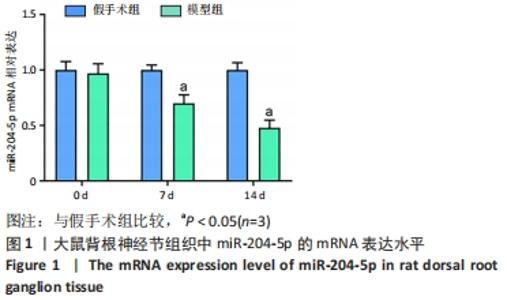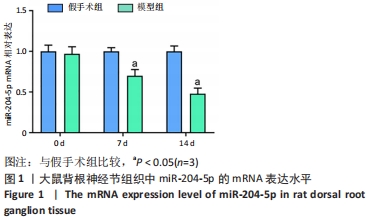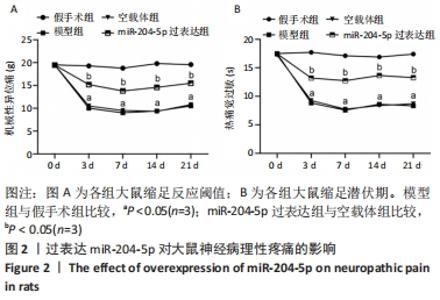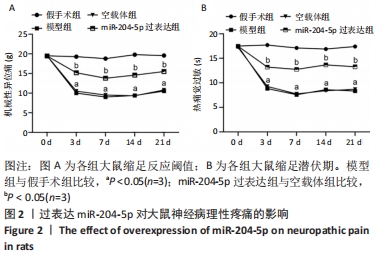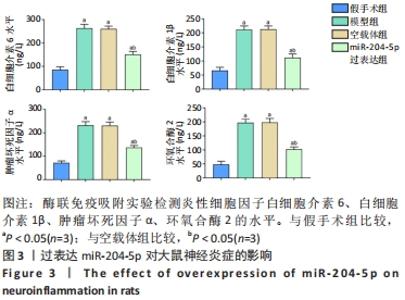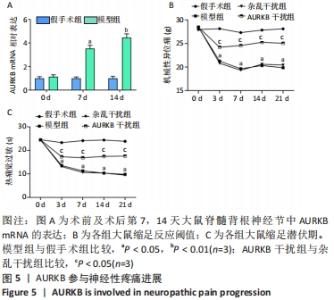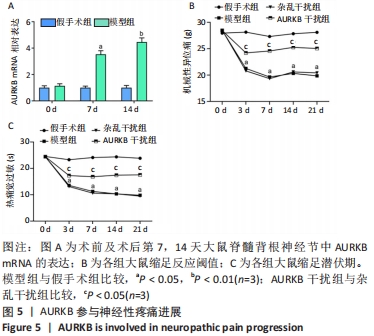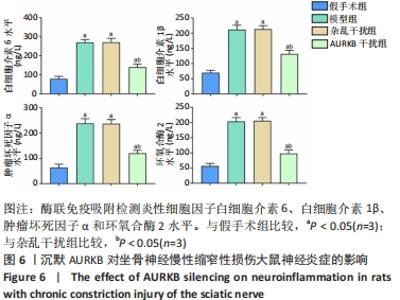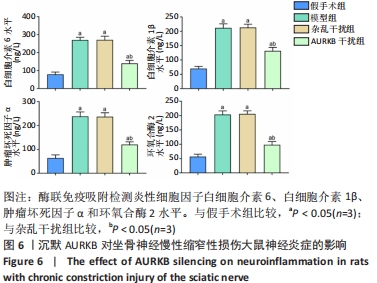Chinese Journal of Tissue Engineering Research ›› 2022, Vol. 26 ›› Issue (29): 4680-4686.doi: 10.12307/2022.839
Previous Articles Next Articles
MiR-204-5p alleviates neuropathic pain in rats with chronic constriction injury
Mao Ke1, Gao Yuhua1, Zhou Songlin1, Zhao Yanfen1, Zhang Yuanyuan1, Du Silong1, Li Xilong2
- 1Department of Anesthesiology, Henan Province Hospital of Traditional Chinese Medicine (the Second Affiliated Hospital of Henan University of Chinses Medicine), Zhengzhou 450002, Henan Province, China; 2Department of Anesthesiology and Perioperative Medicine, Henan Provincial Tumor Hospital (Affiliated Cancer Hospital of Zhengzhou University), Zhengzhou 450002, Henan Province, China
-
Received:2021-08-05Accepted:2021-11-11Online:2022-10-18Published:2022-03-27 -
Contact:Mao Ke, Department of Anesthesiology, Henan Province Hospital of Traditional Chinese Medicine (the Second Affiliated Hospital of Henan University of Chinses Medicine), Zhengzhou 450002, Henan Province, China -
About author:Mao Ke, Attending physician, Department of Anesthesiology, Henan Province Hospital of Traditional Chinese Medicine (the Second Affiliated Hospital of Henan University of Chinses Medicine), Zhengzhou 450002, Henan Province, China -
Supported by:Henan Provincial Medical Science and Technology Research Project, No. LHGJ20200184 (to LXL)
CLC Number:
Cite this article
Mao Ke, Gao Yuhua, Zhou Songlin, Zhao Yanfen, Zhang Yuanyuan, Du Silong, Li Xilong. MiR-204-5p alleviates neuropathic pain in rats with chronic constriction injury[J]. Chinese Journal of Tissue Engineering Research, 2022, 26(29): 4680-4686.
share this article
Add to citation manager EndNote|Reference Manager|ProCite|BibTeX|RefWorks
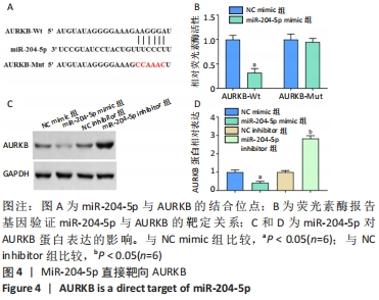
2.4 AURKB是miR-204-5p的靶基因 采用生物信息学分析工具PITA(https://genie.weizmann.ac.il/pubs/mir07/mir07_data.html)预测得知miR-204-5p与AURKB 3?UTR结合,见图4A。HEK-293T细胞共转染AURKB-Wt和miR-204-5p mimic后荧光素酶活性显著下调(P < 0.05),而共转染AURKB-Mut和miR-204-5p mimic后荧光素酶活性无明显变化,见图4B。Western blot结果显示:过表达miR-204-5p抑制AURKB的表达,而抑制miR-204-5p则促进AURKB的表达(P < 0.05),见图4C,D。"
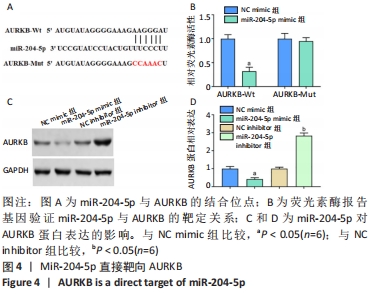
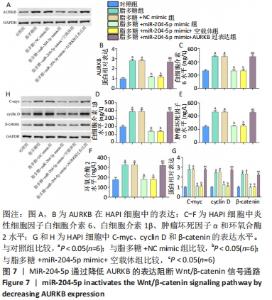
2.7 miR-204-5p通过抑制AURKB的表达阻断Wnt/β-catenin信号通路 Western blot结果显示:与对照组比较,脂多糖组HAPI细胞中AURKB蛋白和Wnt/β-catenin信号通路蛋白(C-myc、cyclin D和β-catenin)的表达水平显著升高(P < 0.05);与脂多糖+NC mimic组比较,脂多糖+miR-204-5p mimic组HAPI细胞中AURKB蛋白和Wnt/β-catenin信号通路蛋白(C-myc、cyclin D和β-catenin)的表达水平显著降低(P < 0.05);与脂多糖+miR-204-5p mimic+空载体组对比,AURKB过表达逆转了miR-204-5p mimic的作用,见图7。酶联免疫吸附实验结果显示:与对照组比较,脂多糖组HAPI细胞中白细胞介素6、白细胞介素1β、肿瘤坏死因子α和环氧合酶2水平显著升高(P < 0.05);与脂多糖+NC mimic组比较,脂多糖+miR-204-5p mimic组HAPI细胞中白细胞介素6、白细胞介素1β、肿瘤坏死因子α和环氧合酶2水平显著降低(P < 0.05);与脂多糖+miR-204-5p mimic+空载体组对比, AURKB过表达逆转了miR-204-5p mimic的作用,见图7。"
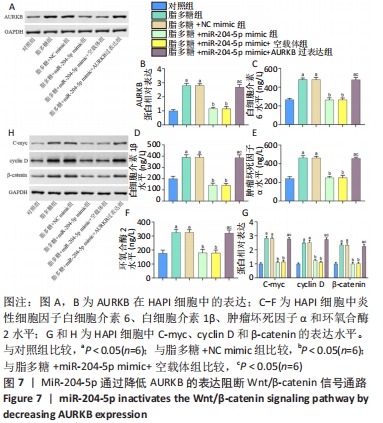
| [1] 寿雯婷,张世红,陈忠.钠离子通道在神经病理性疼痛中的作用研究进展[J].浙江大学学报(医学版),2011,40(2):217-221. [2] VAN HECKE O, AUSTIN SK, KHAN RA, et al. Neuropathic pain in the general population: a systematic review of epidemiological studies. Pain. 2014;155(4):654-662. [3] LEMA MJ, FOLEY KM, HAUSHEER FH. Types and epidemiology of cancer-related neuropathic pain: the intersection of cancer pain and neuropathic pain. Oncologist. 2010;15 Suppl 2:3-8. [4] JIANGPAN P, QINGSHENG M, ZHIWEN Y, et al. Emerging Role of microRNA in Neuropathic Pain. Curr Drug Metab. 2016;17(4):336-344. [5] LÓPEZ-GONZÁLEZ MJ, LANDRY M, FAVEREAUX A. MicroRNA and chronic pain: From mechanisms to therapeutic potential. Pharmacol Ther. 2017;180:1-15. [6] DAYER CF, LUTHI F, LE CARRÉ J, et al. Differences in the miRNA signatures of chronic musculoskeletal pain patients from neuropathic or nociceptive origins. PLoS One. 2019;14(7):e0219311. [7] 梁冰,董铁立.miR-19a对慢性压迫性损伤大鼠神经病理性疼痛的影响及其机制[J].第三军医大学学报,2018,40(7):590-595. [8] ZHANG X, CHEN Q, SHEN J, et al. miR-194 relieve neuropathic pain and prevent neuroinflammation via targeting FOXA1. J Cell Biochem. 2020;121(5-6):3278-3285. [9] SHEN WS, LI CF, ZHOU ZS, et al. MicroRNA-204 silencing relieves pain of cervical spondylotic radiculopathy by targeting GDNF. Gene Ther. 2020;27(6):254-265. [10] WANG Y, YE F, HUANG C, et al. Bioinformatic Analysis of Potential Biomarkers for Spinal Cord-injured Patients with Intractable Neuropathic Pain. Clin J Pain. 2018;34(9):825-830. [11] MOURA DS, CAMPILLO-MARCOS I, VÁZQUEZ-CEDEIRA M, et al. VRK1 and AURKB form a complex that cross inhibit their kinase activity and the phosphorylation of histone H3 in the progression of mitosis. Cell Mol Life Sci. 2018;75(14):2591-2611. [12] SHEN Y, DING Z, MA S, et al. Targeting aurora kinase B alleviates spinal microgliosis and neuropathic pain in a rat model of peripheral nerve injury. J Neurochem. 2020;152(1):72-91. [13] 文苾蕊, 张志玲, 陈乃宏. Wnt信号通路在神经病理性疼痛中的作用及机制研究进展[J].药学学报,2020,55(2):35-41. [14] HU C, ZHAO YT, CUI YB, et al. Wnt/beta-Catenin Signaling Contributes to Vincristine-Induced Neuropathic Pain. Physiol Res. 2020;69(4):701-710. [15] SHEU ML, CHIANG CY, SU HL, et al. Intrathecal Injection of Dual Zipper Kinase shRNA Alleviating the Neuropathic Pain in a Chronic Constrictive Nerve Injury Model. Int J Mol Sci. 2018;19(8):2421. [16] GUO D, HU X, ZHANG H, et al. Orientin and neuropathic pain in rats with spinal nerve ligation. Int Immunopharmacol. 2018;58:72-79. [17] BOUHASSIRA D. Neuropathic pain: Definition, assessment and epidemiology. Rev Neurol (Paris). 2019;175(1-2):16-25. [18] GRACE PM, STRAND KA, GALER EL, et al. Morphine paradoxically prolongs neuropathic pain in rats by amplifying spinal NLRP3 inflammasome activation. Proc Natl Acad Sci U S A. 2016;113(24): E3441-3450. [19] NISHIHARA T, TANAKA J, SEKIYA K, et al. Chronic constriction injury of the sciatic nerve in rats causes different activation modes of microglia between the anterior and posterior horns of the spinal cord. Neurochem Int. 2020;134:104672. [20] PFYFFER D, WYSS PO, HUBER E, et al. Metabolites of neuroinflammation relate to neuropathic pain after spinal cord injury. Neurology. 2020;95(7):e805-e814. [21] LIANG YH, CHEN GW, LI XS, et al. Guanosine-5’-triphosphate cyclohydrolase 1 regulated long noncoding RNAs are potential targets for microglial activation in neuropathic pain. Neural Regen Res. 2021; 16(3):596-600. [22] WU J, WANG C, DING H. LncRNA MALAT1 promotes neuropathic pain progression through the miR‑154‑5p/AQP9 axis in CCI rat models. Mol Med Rep. 2020;21(1):291-303. [23] ZHANG X, ZHANG Y, CAI W, et al. MicroRNA-128-3p Alleviates Neuropathic Pain Through Targeting ZEB1. Neurosci Lett. 2020;729:134946. [24] TIAN J, SONG T, WANG W, et al. miR-129-5p Alleviates Neuropathic Pain Through Regulating HMGB1 Expression in CCI Rat Models. J Mol Neurosci. 2020;70(1):84-93. [25] 夏志强. miRNA-204-5p靶向RAB22A调控胶质瘤增殖、迁移与侵袭的机制分析[D].北京:北京协和医学院,2016. [26] GAO J, WANG Y, ZHAO X, et al. MicroRNA-204-5p-Mediated Regulation of SIRT1 Contributes to the Delay of Epithelial Cell Cycle Traversal in Diabetic Corneas. Invest Ophthalmol Vis Sci. 2015;56(3):1493-1504. [27] LI H, WANG J, LIU X, et al. MicroRNA-204-5p suppresses IL6-mediated inflammatory response and chemokine generation in HK-2 renal tubular epithelial cells by targeting IL6R. Biochem Cell Biol. 2019;7(2): 109-117. [28] Nie M, Wang Y, Yu Z, et al. AURKB promotes gastric cancer progression via activation of CCND1 expression. Aging (Albany NY). 2020;12(2): 1304-1321. [29] HUANG D, HUANG Y, HUANG Z, et al. Relation of AURKB over-expression to low survival rate in BCRA and reversine-modulated aurora B kinase in breast cancer cell lines. Cancer Cell Int. 2019;19:166. [30] LEE JY, CHOI HY, JU BG, et al. Estrogen alleviates neuropathic pain induced after spinal cord injury by inhibiting microglia and astrocyte activation. Biochim Biophys Acta Mol Basis Dis. 2018;1864(7): 2472-2480. [31] TSUDA M. Microglia-Mediated Regulation of Neuropathic Pain: Molecular and Cellular Mechanisms. Biol Pharm Bull. 2019;42(12): 1959-1968. [32] TOZAKI-SAITOH H, TSUDA M. Microglia-neuron interactions in the models of neuropathic pain. Biochem Pharmacol. 2019;169:113614. [33] 王菲菲, 韩光, 杜英杰,等.Wnt/β-catenin信号通路在高压氧治疗大鼠神经病理性痛中的作用[J].临床麻醉学杂志,2016,32(2):171-174. [34] ITOKAZU T, HAYANO Y, TAKAHASHI R, et al. Involvement of Wnt/beta-catenin signaling in the development of neuropathic pain. Neurosci Res. 2014;79:34-40. [35] FAN X, BIAN W, LIU M, et al. MiR-216b-5p attenuates chronic constriction injury-induced neuropathic pain in female rats by targeting MAL2 and inactivating Wnt/β-catenin signaling pathway. Neurochem Int. 2020;28:104930. [36] LUO Y, BARRIOS-RODILES M, GUPTA GD, et al. Atypical function of a centrosomal module in WNT signalling drives contextual cancer cell motility. Nat Commun. 2019;10(1):2356. [37] LEE KB, JIN H, YE S, et al. Recombinant human bone morphogenetic protein-2 inhibits gastric cancer cell proliferation by inactivating Wnt signaling pathway via c-Myc with aurora kinases. Oncotarget. 2016; 7(45):73473-73485. [38] SUBRAMANIYAN B, KUMAR V, MATHAN G. Effect of sodium salt of Butrin, a novel compound isolated from Butea monosperma flowers on suppressing the expression of SIRT1 and Aurora B kinase-mediated apoptosis in colorectal cancer cells. Biomed Pharmacother. 2017;90:402-413. |
| [1] | Wang Jianping, Zhang Xiaohui, Yu Jinwei, Wei Shaoliang, Zhang Xinmin, Xu Xingxin, Qu Haijun. Application of knee joint motion analysis in machanism based on three-dimensional image registration and coordinate transformation [J]. Chinese Journal of Tissue Engineering Research, 2022, 26(在线): 1-5. |
| [2] | FAN Yaru, LI Ruixin , LI Fengji, LUO Rui, LIU Hao, YAN Yingbin. Characterization and photothermal effect of indocyanine green encapsulated poly lactic acid-co-glycolic acid microspheres [J]. Chinese Journal of Tissue Engineering Research, 2022, 26(在线): 1-6. |
| [3] | Bao Xianguo, Gao Zengxin, Wu Zhanpo, Chen Youmin, Cheng Qinghua, Lu Haitao, Guo Changzheng, Xu Shuai. Correlation between lumbar posterior muscle and local kyphosis in patients with degenerative thoracolumbar kyphosis [J]. Chinese Journal of Tissue Engineering Research, 2022, 26(9): 1418-1423. |
| [4] | Zhang Haobo, Zhao Yunan, Yang Xuejun. Role and therapeutic implications of pyroptosis in intervertebral disc degeneration [J]. Chinese Journal of Tissue Engineering Research, 2022, 26(9): 1445-1451. |
| [5] | Jing Jinpeng, Zhang Yue, Liu Xiaomin, Liu Yi. Traditional Chinese medicine injection for promoting blood circulation in prevention of deep vein thrombosis after orthopedic surgery: network meta-analysis [J]. Chinese Journal of Tissue Engineering Research, 2022, 26(9): 1467-1476. |
| [6] | Li Huo, Wang Peng, Gao Jianming, Jiang Haoran, Lu Xiaobo, Peng Jiang. Relationship between revascularization and internal microstructure changes in osteonecrosis of the femoral head [J]. Chinese Journal of Tissue Engineering Research, 2022, 26(9): 1323-1328. |
| [7] | Gu Zhengqiu, Xu Fei, Wei Jia, Zou Yongdi, Wang Xiaolu, Li Yongming. Exploratory study on talk test as a measure of intensity in blood flow restriction training [J]. Chinese Journal of Tissue Engineering Research, 2022, 26(8): 1154-1159. |
| [8] | Kong Yamin, Yan Juntao, Ma Bingxiang, Li Huawei. Massage vibration intervenes with MyoD expression and proliferation and differentiation of muscle satellite cells in rats with sciatic nerve injury [J]. Chinese Journal of Tissue Engineering Research, 2022, 26(8): 1160-1166. |
| [9] | Wu Cong, Jia Quanzhong, Liu Lun. Relationship between transforming growth factor beta1 expression and chondrocyte migration in adult articular cartilage after fragmentation [J]. Chinese Journal of Tissue Engineering Research, 2022, 26(8): 1167-1172. |
| [10] | Li Zhiyi, He Pengcheng, Bian Tianyue, Xiao Yuxia, Gao Lu, Liu Huasheng. Bibliometric and visualized analysis of ferroptosis mechanism research [J]. Chinese Journal of Tissue Engineering Research, 2022, 26(8): 1202-1209. |
| [11] | Xiang Xinjian, Liu Fang, Wu Liangliang, Jia Daping, Tao Yue, Zhao Zhengnan, Zhao Yu. High-dose vitamin C promotes the survival of autologous fat transplantation in rats [J]. Chinese Journal of Tissue Engineering Research, 2022, 26(8): 1242-1246. |
| [12] | Zhu Chan, Han Xuke, Yao Chengjiao, Zhang Qiang, Liu Jing, Shao Ming. Acupuncture for Parkinson’s disease: an insight into the action mechanism in animal experiments [J]. Chinese Journal of Tissue Engineering Research, 2022, 26(8): 1272-1277. |
| [13] | Kan Houming, Fan Lijun, Chen Xuetai, Shen Wen. Application of platelet-rich plasma in neuropathic pain [J]. Chinese Journal of Tissue Engineering Research, 2022, 26(8): 1286-1292. |
| [14] | Wang Jifang, Bao Zhen, Qiao Yahong. miR-206 regulates EVI1 gene expression and cell biological behavior in stem cells of small cell lung cancer [J]. Chinese Journal of Tissue Engineering Research, 2022, 26(7): 1027-1031. |
| [15] | Zhu Bingbing, Deng Jianghua, Chen Jingjing, Mu Xiaoling. Interleukin-8 receptor enhances the migration and adhesion of umbilical cord mesenchymal stem cells to injured endothelium [J]. Chinese Journal of Tissue Engineering Research, 2022, 26(7): 1045-1050. |
| Viewed | ||||||
|
Full text |
|
|||||
|
Abstract |
|
|||||
